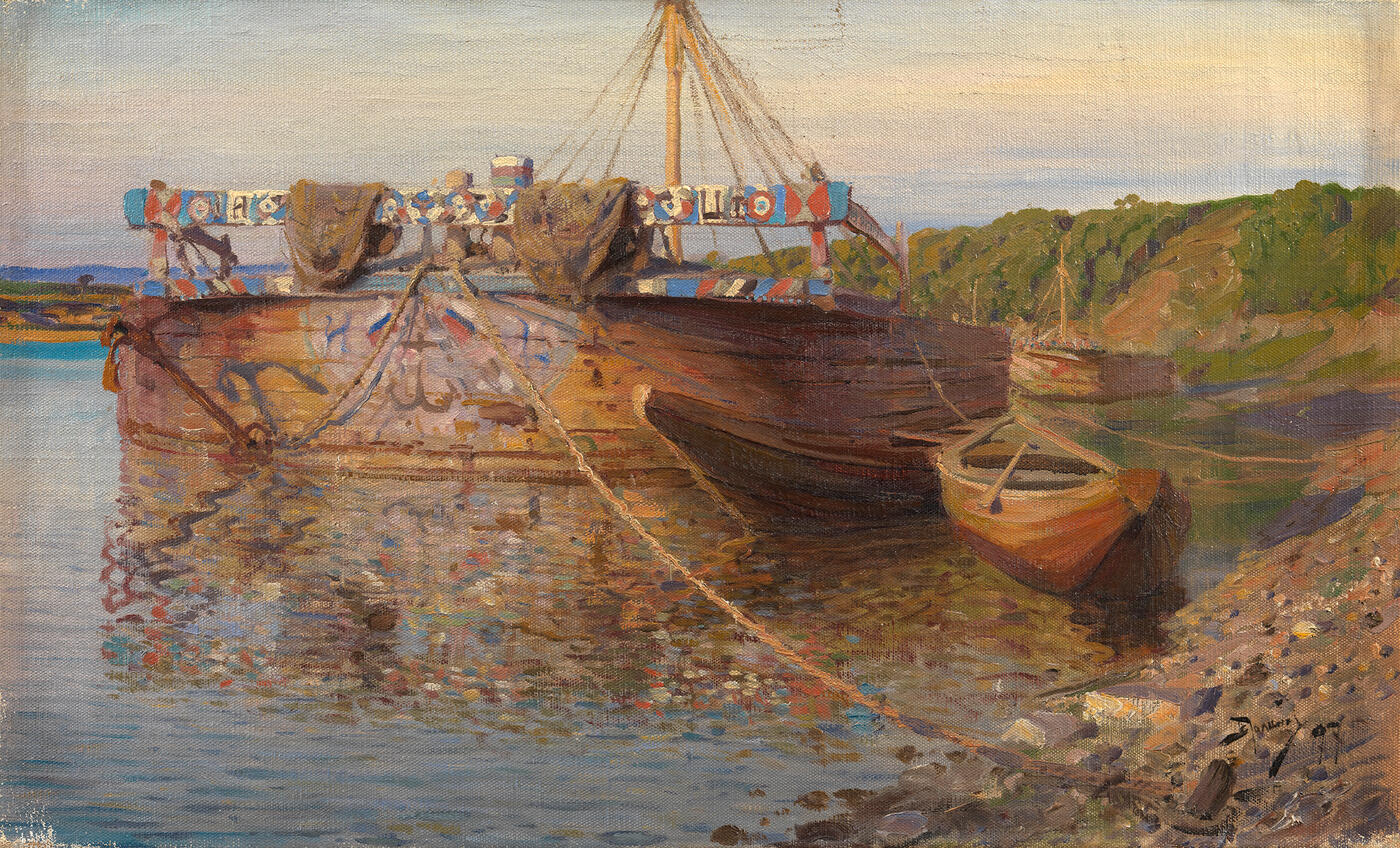3 June 2015 Russian Art Auctions
3 June 2015

56. POLENOV, VASILY (1844-1927)
Barge on the River Oka, signed and dated 1897, further numbered "N 476" on the reverse.
Oil on canvas, 40.5 by 65.5 cm.
200,000-300,000 GBP
Provenance: The Yasher-Sheftell collection, from the 1940s.
Thence by descent to the previous owner.
Private collection, UK.
Authenticity of the work has been confirmed by the expert V. Petrov.
Exhibited: XXVI vystavka Tovarishchestva peredvizhnykh khudozhestvennykh vystavok, St Petersburg, Moscow, Penza, Kharkov, Ekaterinoslav, Elizavetgrad, Poltava, Kiev, Smolensk, Kaluga, 22 February 1898–21 February 1899, No. 3-136.
Literature: Exhibition catalogue, Illiustrirovannyi katalog XXVI vystavki Tovarishchestva peredvizhnykh khudozhestvennykh vystavok. 1898 g., Moscow, Khudozhestvennaya fototipia K.A. Fisher, 1898.
G. Romanov, Tovarishchestvo peredvizhnykh khudozhestvennykh vystavok. 1871–1923 gg., entsiklopedia, St Petersburg, Sankt-Peterburg Orkestr, 2003, p. 203, No. 3-136, listed.
Vassily Polenov’s artistic pursuits of the late 1890s are inseparably linked to his life at the Borok estate on the banks of the Oka. It was here that he painted most of his famous river landscapes (Valley of the Oka and Golden Autumn, for example), including the splendid canvas painted from nature and offered here at auction – Barge on the River Oka.
Polenov had acquired his country seat near Tarusa, high on the river bank, and spent the summer of 1897 there, relishing his work en plein air. The artist was especially drawn to the decoratively painted unzhak salt barges, which were drawn by horses every year in convoy up the Oka to deliver salt from Nizhny Novgorod to Tarusa and Kaluga. The barges had become ubiquitous throughout the upper and central Volga region as early as the 18th century and had preserved their traditional look for many years, with their ornamental carving and festive woodwork brightly painted in three colours. Polenov, who delighted in the revival of popular crafts and indigenous industries, could not resist the antique beauty of the unzhak barges.
At the heart of the composition Barge on the River Oka the artist places the distinctive image of an unzhak barge quietly at her moorings, at a shoal in the river. The lively ripples of the water, sparkling highlights of colour, the lightness of the shining sky and the barely defined vegetation on the shoreline are all witness to the rapidity with which Polenov worked from nature, striving to convey the special atmosphere and radiance of the scene – and to capture the moment when the sun begins to sink and the light fades. At the same time, even a swift glance reveals Polenov’s skill in configuring the main and secondary features, the round side of the barge and the curve of the river. In addition, the extended horizontal format of the picture and the low eye level of vision, which seems to “carve out” the mast and rigging, endow this seemingly intimate work with the qualities of an epic landscape.
Even in such a lyrical landscape, it is extremely important to the artist that the details should be authentic. The letters “I” and “Ts” can be read on the edges of the ornamentation, being the initials of the merchant Ivan Tsipulin, to whom the jetty and shipping company in Kaluga belonged and who owned the lion’s share of passenger and freight transport on the Oka waterway.
On the back of the canvas is the number 476, which according to a list of the artist’s work relates to a picture called Barge and allows this painting to be spoken of not only as indisputably by Polenov, but also as a brilliant example of the artist’s Oka work, painted with romanticised air of national-historicism.
Notes on symbols:
* Indicates 5% Import Duty Charge applies.
Ω Indicates 20% Import Duty Charge applies.
§ Indicates Artist's Resale Right applies.
† Indicates Standard VAT scheme applies, and the rate of 20% VAT will be charged on both hammer price and premium.